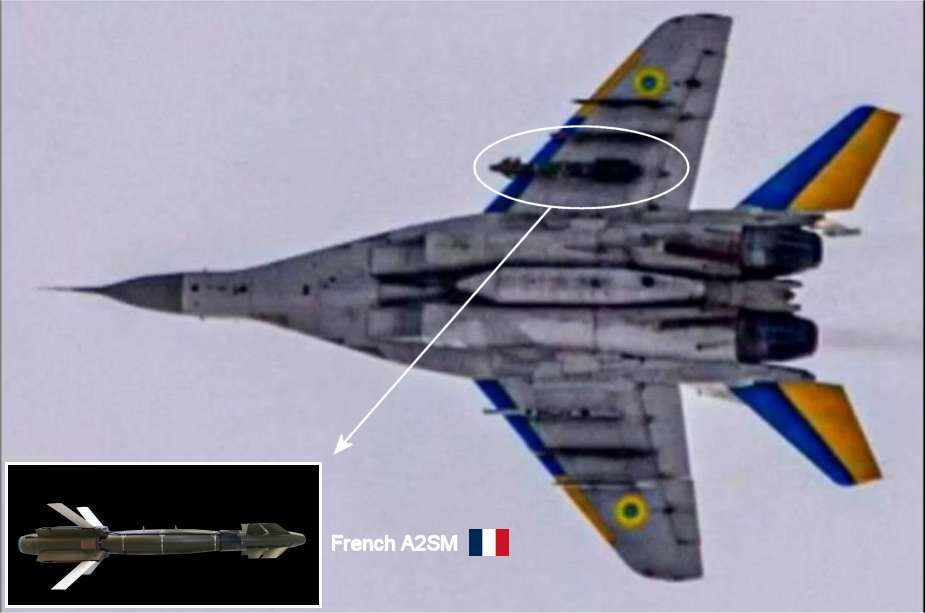- Army
- Conflicts in the world
- Israel - Iran conflict 2025
- Pakistan - India Conflict 2025
- Russia Ukraine War 2022
- Libya conflict day by day
- HAMAS - Israel War 2023
- Operation Serval in Mali French Army
- Sangaris operation Central African Republic
- Sangaris opération militaire République Centreafrique
- Ukraine - Russia conflict
- Syria conflict news
- Defence & Security Industry Technology
- Armies in the world
- Analysis Defense and Security Industry
- Conflicts in the world
- Navy
- Air
Ukraine confirms MiG-29 jets capable of carrying French-provided A2SM Hammer bombs
Kyiv has confirmed that its MiG-29 "Fulcrum" fighter jets can carry the A2SM "Hammer" bombs supplied by France, marking a significant development in the context of the war in Ukraine. Facing the challenge of operating primarily Soviet-era equipment, in the absence of modern Western fighter bombers such as the F-16, the Ukrainian Air Force has had to adapt its aircraft to be able to carry Western munitions, a technical challenge given the outdated electronic systems of these planes.
Follow Army Recognition on Google News at this link

Kyiv has confirmed that its MiG-29 "Fulcrum" fighter jets can carry the A2SM "Hammer" bombs supplied by France. (Picture source: Open source information)
In 2022, modifications were made to enable the MiG-29 to utilize the American AGM-88 HARM anti-radar missile, involving the installation of a specific pylon and an external battery for electrical power, connected to the plane's radar. This adaptation was also applied to the Su-27.
The Ukrainian air forces also have access to JDAM-ER bombs, and Mk82s equipped with GPS and inertial navigation system guidance, allowing for launches from a safe distance. The integration of Polish and Slovak MiG-29s to NATO standards likely simplified the adaptation of these bombs, necessitating the design of a specific pylon.
These same modifications have seemingly enabled the carriage of French A2SM "Hammer" bombs, as reported by the Defense Express website, following the analysis of a photograph showing a MiG-29 armed with such a bomb. This new capability is part of a French delivery of 50 A2SMs per month to Ukraine, in addition to extra cruise missiles.
The Modular Air-Ground Weapon (A2SM), also known as "Hammer", is a precision-guided munition developed by France. In service since 2007, it is used by several air forces worldwide, including the French Air and Space Force, French Naval Aviation, and the air forces of Morocco, Egypt, Qatar, India, and more recently, Ukraine. It has been deployed in various conflicts such as the War in Afghanistan, the 2011 Libyan civil war, the Northern Mali conflict, Operation Inherent Resolve, and now in the Russo-Ukrainian conflict.
Manufactured by Safran Electronics & Defense, the A2SM's unit cost was approximately 164,000 euros in 2011, a figure that could reach 252,000 euros when development costs are included. The standard version of this munition weighs 340 kg, with a 250 kg bomb body that can be a Mk82, BLU 111, or CBEMS/BANG, and measures 3.1 meters in length. It is propelled by a solid rocket motor and can be launched from various platforms including the Dassault Rafale, Mirage 2000D, Mirage F1, F-16, Tejas, and now the MiG-29.
The A2SM is distinguished by its ability to strike targets with high precision thanks to its hybrid guidance system, combining inertial navigation and GPS, thus offering an all-weather decametric version and a metric day/night version that may include infrared homing or semi-active laser homing (SALH). Its operational range exceeds 70 km, allowing for precise strikes from a safe distance. Its accuracy is remarkable, with a circular error probable (CEP) of 10 meters for the decametric version and 1 meter for the metric version, ensuring formidable effectiveness against designated targets, regardless of weather conditions.
The operational use of A2SMs by Ukraine was reported as early as March 3rd during an attack against Russian positions, marking a significant strategic evolution. This enhanced ability to conduct precise strikes from a safe distance represents a significant tactical advantage for Ukraine, illustrating an innovative approach to adapting Western technologies on Soviet-era aerial platforms in response to the challenges posed by the ongoing conflict.


























